
Hi friends! My name is Petra and today, I want to talk a little bit about what rowing does for the body.
Is rowing primarily an anaerobic burst of power or a sustained aerobic endurance exercise?
The quick answer is-
“Rowing is both aerobic and anaerobic! It is a centuries-old sport and a popular fitness activity.”

I have been asked more than once about the metabolic nature of rowing. Not really knowing the answer myself, I had to do a little research, and it appears that this question has sparked debates among fitness enthusiasts, athletes, and researchers alike.
Understanding the physical demands of rowing is crucial for those who want to optimize training programs, improve performance, and tailor workouts to specific fitness goals. What I discovered was pretty darn interesting.
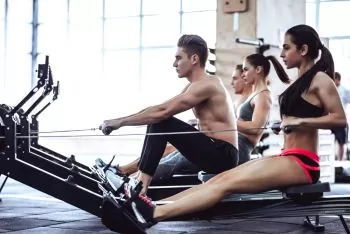
In today’s article, I will try to delve into the science behind rowing’s energy systems and not get too technical.
Whether you’re a rowing enthusiast or simply seeking to enhance your exercise routine, check out what I have discovered about aerobic vs anaerobic.
For Those Short on Time: Here’s the Scoop
If you don’t have time to read the entire article, here are a few takeaways-
- Rowing engages both anaerobic and aerobic energy systems.
- The rowing stroke involves quick, explosive movements during the drive phase, activating anaerobic pathways for short bursts of intense effort.
- The anaerobic component of rowing helps build muscle strength and power, while the aerobic aspect contributes to overall muscular endurance and stamina.
There’s a lot more, so bookmark this page and read the entire article later!

What Is Anaerobic and Aerobic Exercise?
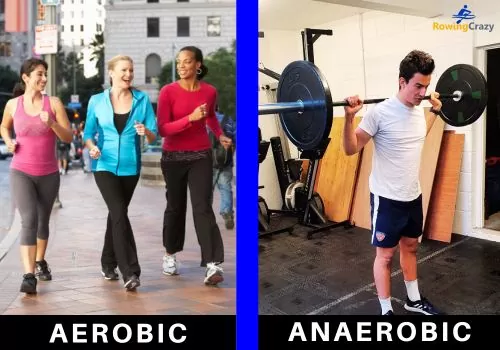
This can get pretty complicated, so let me try to put this in simple terms:
Aerobic exercise: This is any activity that gets your heart pumping and makes you breathe harder. During aerobic exercise, your body uses oxygen to produce energy. This type of exercise is usually done at a moderate intensity for an extended period. Examples include brisk walking, jogging, swimming, or rowing.
Anaerobic exercise: Unlike aerobic exercise, anaerobic activities are short bursts of intense effort that doesn’t rely on oxygen for energy. In these exercises, your body uses stored energy in your muscles for quick bursts of power. Examples of anaerobic exercises include sprinting, weightlifting, rowing, and jumping. Anaerobic exercise helps build strength, power, and muscle mass.
In short, anaerobic workouts are when you use the fuel that is stored in your muscles, while aerobic workouts use the energy that you get from the air you are breathing.
Is Rowing More Aerobic or Anaerobic?
This is an easy one- it’s both! It leans more toward being an aerobic exercise, but the truth is that it depends on your workout.
If you are doing HIIT workouts, then it is more anaerobic, and this is especially true of those rowing in regattas or races. You work out at a steady pace then do short bursts of intense exercise.
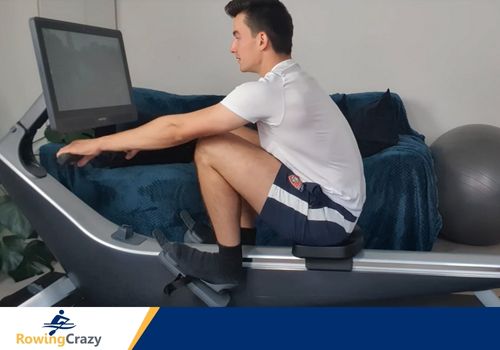
Erg with Your Feet Out with Max Secunda
For the majority of people who are simply looking for a good cardio workout, they mainly do aerobic exercise. This is especially true for non-professionals using an erg (an indoor rowing machine).
Your cardiovascular system and muscles benefit from both types of exercise. However, if you want to improve your rowing performance and get a maximal power output, or if you plan on racing or rowing professionally, you’ll want to get in some anaerobic workouts.
This doesn’t mean that aerobic workouts aren’t giving your training volume or muscular strength. The fact is that both an anaerobic workout and an aerobic workout are good for you!
Which Burns More Fat and Calories- Aerobic or Anaerobic Workouts?
Aerobic exercise generally burns more calories than anaerobic exercise while you are exercising. This is because aerobic activities, such as rowing or working out on the erg, are performed at moderate intensity over an extended period, leading to a sustained calorie burn.
The body relies on oxygen to produce energy, which allows it to keep going for longer durations, resulting in higher overall calorie expenditure.
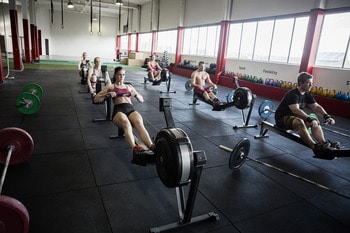
It’s important to note that anaerobic workouts, such as HIIT rowing, are known by the short bursts of intense effort that break into your anaerobic system. However, although anaerobic exercises do burn calories, the total calorie expenditure during the activity is typically lower than during aerobic exercises.
Now let’s consider the “afterburn” effect. After an intense anaerobic workout, the body needs to recover, which can result in additional calorie burn for hours after you’ve stopped exercising. This afterburn effect can cause you to actually burn more calories in a shorter amount of time than an aerobic workout.
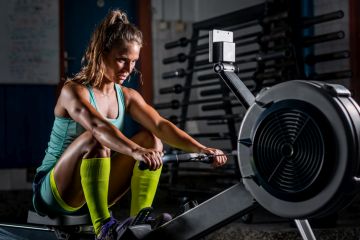
This is why many professional athletes and those looking to lose weight go for HIIT rowing workouts either on the water or on the rowing machine. Your anaerobic metabolism kicks in, causing you to burn fat for many hours after you’ve completed your exercise.
Less time exercising and more calorie and fat burning? Sounds like a great workout plan to me!
Is Rowing the Best Form of Cardio?
This is not an easy question since we would need to decide what “best” means.
If you aren’t a fan of rowing, I don’t care how good it is for you, chances are that you won’t keep it up. No one wants to do something they dislike day after day.
Rowing vs Cycling: Watch Max Secunda Present the Ultimate Comparison:
However, if by “best” we mean cardiovascular endurance and an intense workout that uses nearly every muscle in the body, then yes, rowing is one of the best, if not the best form of cardio exercise.
In order to determine the best form of cardio exercise for you, consider the following:
- Enjoyment: The best cardio exercise truly is the one you enjoy since there’s the greater likelihood of you sticking to your fitness routine.
- Fitness goals: Different exercises may be better suited to specific goals, such as improving endurance, strength, or overall fitness. I always recommend cross-training to my clients and friends.
- Physical limitations: Take into account any existing injuries or conditions that may impact your ability to perform certain activities. This is where rowing excels since even those with injuries can often row when other exercises aren’t a viable option.
- Variety: Incorporating a variety of cardio exercises can help prevent boredom and work different muscle groups. Again, cross-training is the way to go. Nothing kills your exercise plans like boredom so knowing this in advance means you can avoid the boredom factor.
I love rowing because I get both an anaerobic and aerobic workout, including strength training and other benefits every time I sit down in the boat or the erg.
Only jumping rope burns more fat than rowing, but my knees ache just thinking about jumping rope for an hour every day!
Does Rowing Build Aerobic Endurance?
Yes, it does!
Aerobic endurance means that your cardiovascular system can deliver oxygen to the muscles efficiently so you can continue performing your task (in this case, rowing).
Underutilized Muscles on the Rowing Machine: Watch Insights by Max Secunda
When you consider the continuous and rhythmic motion of a rowing workout and how it uses the large muscles in the body over an extended period, it’s easy to see how rowing, either on the water or on the erg, can build aerobic endurance.
Adding rowing workouts to your exercise routine can improve your overall heart function, maximal oxygen consumption, and overall lung capacity, among other things.
Remember that building aerobic endurance takes time and consistency. Gradually increasing the duration and intensity of your rowing workouts, along with proper rest, will contribute to noticeable improvements in your aerobic fitness over time.
Before You Head Out
I’m sure that after reading this you are all hyped up and ready to jump in the boat or onto the seat of your erg and strap down your feet, but just one more minute of your time, please.
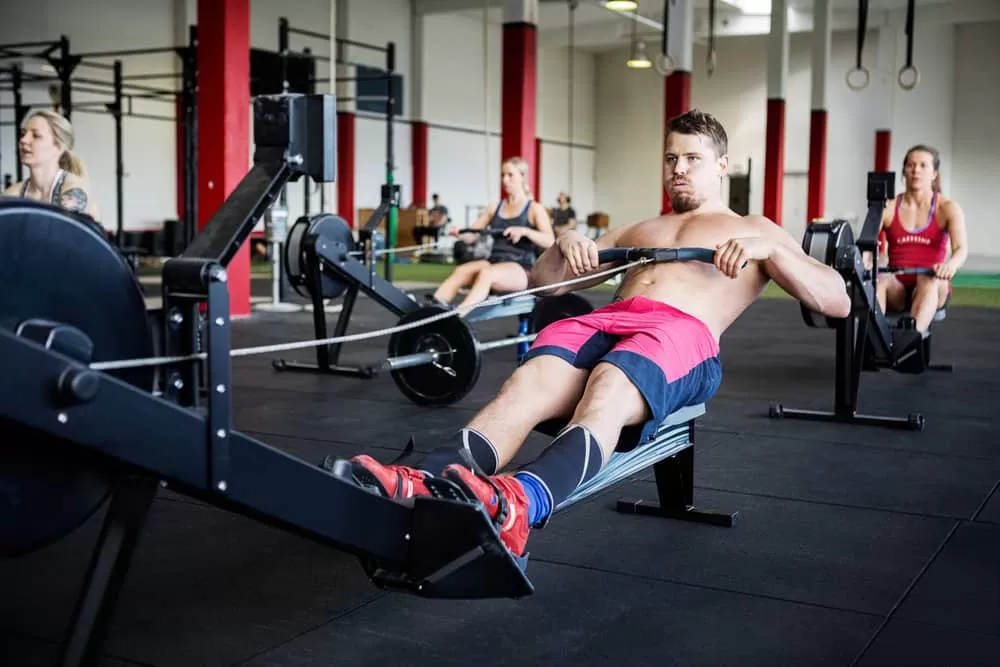
When it comes to the question of is rowing anaerobic or aerobic, I hope you found your answer here.
Whether you’re an avid rower, a fitness enthusiast, or simply curious about rowing, understanding the interplay between aerobic and anaerobic training sheds light on the many benefits of this exciting activity.
Incorporating rowing into your fitness routine is one of the best ways I can think of that can lead you to a healthier cardiovascular system, increased muscular strength, and enhanced overall fitness.
I have a real passion for the versatility of rowing, and if you do as well, I hope you take some time to read through some of the other articles on this page.
Stay healthy and happy, friends! Have fun rowing!
FAQs
1. Is jogging aerobic or anaerobic exercise?
Jogging is mainly aerobic. While you can do sprints, which would be anaerobic, most people jog at a steady pace, which would be aerobic exercise.
2. Is biking anaerobic or aerobic exercise?
Biking, whether outdoors or on a stationary bike, can be both aerobic or anaerobic depending on how you perform it. Like rowing, you can ride a bike at a steady pace or add spurts of high-intensity exercise (HIIT) which would make it anaerobic.
3. Is walking aerobic or anaerobic exercise?
Walking is, for the most part, aerobic exercise. If you did short bursts of intensity by walking quickly uphill or doing sprints, you could change it to anaerobic, but most people walk for a set number of minutes or miles and keep a steady pace, which is aerobic exercise.
4. Is swimming aerobic or anaerobic exercise?
Swimming is mostly aerobic exercise. You could do a few laps across the pool swimming as fast as you could, which would be anaerobic, but the majority of swimmers who use a pool for exercise do continuous laps at a steady pace, which is aerobic exercise.
5. Are planks anaerobic or aerobic exercise?
As strange as it might seem planks are anaerobic exercise. During a plank, you hold a push-up position with your body in a straight line, supported by your forearms and toes. This position activates and engages various muscle groups, such as the core, shoulders, arms, and legs, to maintain stability and proper alignment. Since planks involve holding a fixed position rather than performing repetitive movements, they do not significantly elevate the heart rate or require continuous oxygen supply. Instead, they rely on the stored energy in the muscles, making them anaerobic in nature.
Written by Petra Amara – RowingCrazy.com
CEO & Founder of RowingCrazy, National Rower, Coxswain Womens Eight Team, Rowing Coach & Writer
Petra is a Mother of two and owner of Rowingcrazy.com. Petra lives and breathes rowing, she also has a passion for writing which lead her to start RowingCrazy.com to share her rowing experience and expertise with others.





